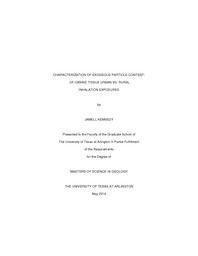
ATTENTION: The works hosted here are being migrated to a new repository that will consolidate resources, improve discoverability, and better show UTA's research impact on the global community. We will update authors as the migration progresses. Please see MavMatrix for more information.
Show simple item record
| dc.contributor.author | Kennedy, Jamell | en_US |
| dc.date.accessioned | 2014-07-14T20:20:47Z | |
| dc.date.available | 2014-07-14T20:20:47Z | |
| dc.date.issued | 2014-07-14 | |
| dc.date.submitted | January 2014 | en_US |
| dc.identifier.other | DISS-12662 | en_US |
| dc.identifier.uri | http://hdl.handle.net/10106/24384 | |
| dc.description.abstract | Exogenous zinc (Zn) is emerging as a serious contaminant in the environment. Yearly deposition of zinc particles line heavily traveled inner city roadways and less traveled rural roadways. Particle size for zinc ranges from approximately PM10 to PM 2.5 µm or less. These fine particles contain microscopic solids or liquids that can cause serious health problems. PM10 are considered to be "thoracic" sized particles, with the mass fraction of inhaled particles penetrating beyond the larynx. Whereas, PM2.5 are considered to be "respirable" sized particles, with the mass fraction of inhaled particles penetrating to the unciliated airways. Exogenous zinc can be used as a quantifiable marker to contrast the differences in exposures in canines originating from urban and rural environments. These exposures are analyzed using a scanning electron microscope with energy dispersive X-ray spectrometry, and usage of a morphometric point counting method for a physical count and categorization of composition of inhaled retained particle content. | en_US |
| dc.description.sponsorship | Hunt, Andrew | en_US |
| dc.language.iso | en | en_US |
| dc.publisher | Geology | en_US |
| dc.title | Characterization Of Exogeous Particale Content: Of Canine Tissue Urban Vs. Rural Inhalation Exposures | en_US |
| dc.type | M.S. | en_US |
| dc.contributor.committeeChair | Hunt, Andrew | en_US |
| dc.degree.department | Geology | en_US |
| dc.degree.discipline | Geology | en_US |
| dc.degree.grantor | University of Texas at Arlington | en_US |
| dc.degree.level | masters | en_US |
| dc.degree.name | M.S. | en_US |
Files in this item
- Name:
- Kennedy_uta_2502M_12662.pdf
- Size:
- 4.542Mb
- Format:
- PDF
This item appears in the following Collection(s)
Show simple item record


